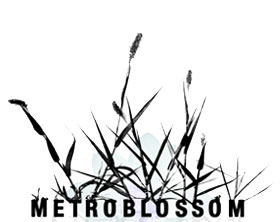|
|
metroblossom was last updated in 2007 but is preserved on this website. If you're looking for more current information material by David Schalliol, visit his website.
metroblossom is a collaborative space for exploring the interaction between humans and the nonhuman world. In particular, those presenting their work through this project are interested in the informal and undocumented life with which we are in constant interaction. Through these explorations, metroblossom argues that all life is meaningful, important, and more than worthy of our recognition.
 The following thoughts will give those who have questions about the project a better sense of my intentions with metroblossom. As with any periodical, this site is a work in progress.
The following thoughts will give those who have questions about the project a better sense of my intentions with metroblossom. As with any periodical, this site is a work in progress.
Submissions of all types for the next issue are welcome (e.g. painting, photography, poetry, essays, music, computer programs, etc.). If you'd like to get involved, please get in touch.
-- David Schalliol
First and foremost, metroblossom is about creation. The intrusion of unplanned life onto human-altered space has a transformative power that turns rust into art, monuments into sanctuaries and refuse into sustenance.
But we -- humans -- have transformed our physical and cultural environments to suppress spontaneous, creative uses of space. The private and public, local and global, commercial and nonprofit -- our divisions and methods of discourse and action -- combine with the pickax and petrochemicals to impose our vision on the world around us.
Nonhuman life bears the brunt of this domination. Unnecessary, illegible, invisible. If it cannot be harnessed, it is ignored or suppressed.
But it is everywhere you look.
When you stare out your office window, when you see a flock of birds fly over your traffic-bound car, when you walk by the "abandoned" lot down the street. Everywhere. These fragments are glimpses into the world we do not see -- glimpses we've all been trained to ignore.
Herein lies a paradox -- what we do not see is as important, if not more important, than what we do see. In the superimposition of the gnarled grid of the city onto the even more twisted root structure of the earth, the unplanned, often nonhuman, world reacts to and acts on us.
The passage of time, as we currently experience it, is an inevitability. With this passing comes the gradual and subtle wreckage of urban planning, shifts in dreams and the creation of something simultaneously new and ever-present.
But is planning truly wrecked? In what ways do planners compensate for the unplanned? In what ways do those adjustments matter? In what way is the intended use of space a lark? Like a work-to-rule strike, what would planning be like if it were achieved?
When a factory is closed, a drop of rain strikes the pavement, or a plot of land is purchased but goes undeveloped, these spaces, while held in intentional human stasis, take on a life of their own.
This unacknowledged vibrancy expresses volumes about the human condition and our interaction with the world around us.
metroblossom seeks to document this shift, and to point an eye at beauty in its many forms.
But what are the ramifications of our gaze?
Human beings have become new glaciers, carving hills and caves into the green earth.
metroblossom is a time-lapse photograph of these glaciers melting.
Of course, it's not that simple.

|
|






